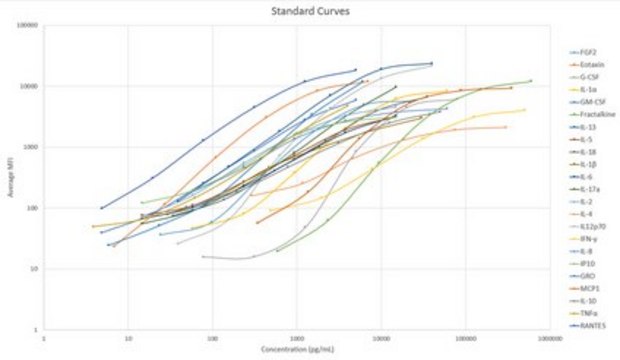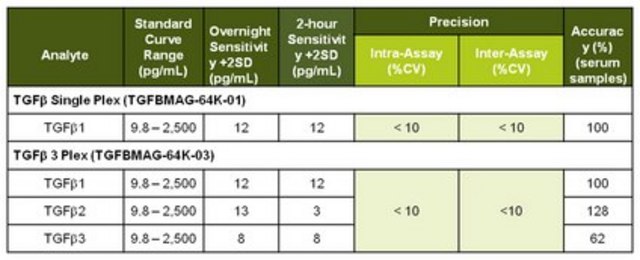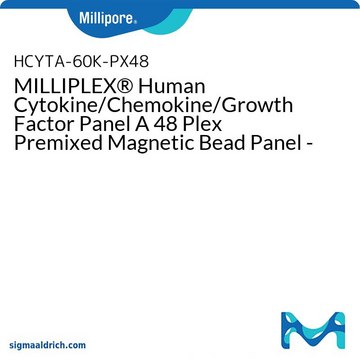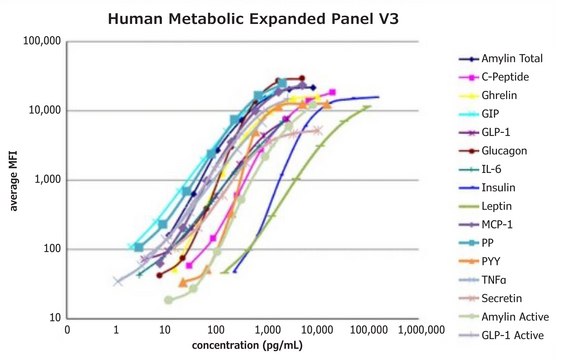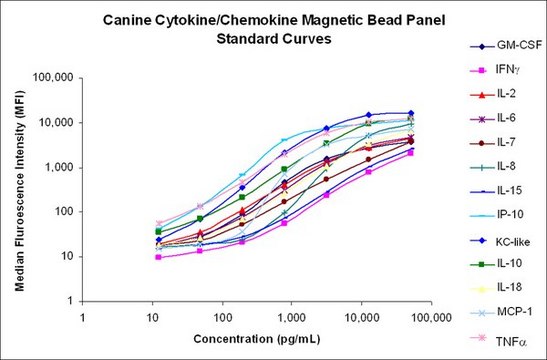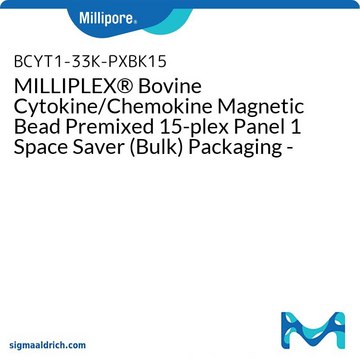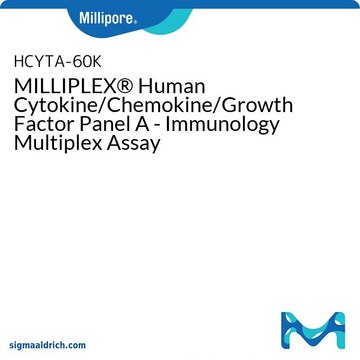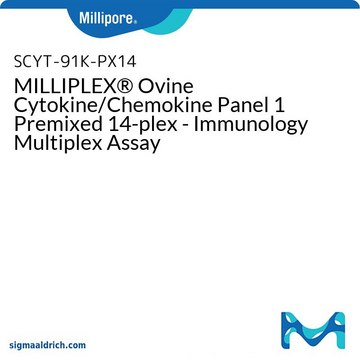EQCYTMG-93KPX23
MILLIPLEX® Equine Cytokine/Chemokine Magnetic Bead Panel Premixed 23-Plex Panel - Immunology Multiplex Assay
The Equine Inflammation / Immunology Bead-Based Multiplex Cytokine Assay kit, using the Luminex xMAP technology, enables the simultaneous analysis of 23 cytokine and chemokine biomarkers in equine serum, plasma and cell culture samples.
About This Item
Recommended Products
Quality Level
species reactivity
horse
manufacturer/tradename
Milliplex®
assay range
accuracy: 76%
(IL-6)
accuracy: 78%
(FGF-2)
accuracy: 82%
(G-CSF)
accuracy: 85%
(IL-13)
accuracy: 87%
(TNFα)
accuracy: 88%
(RANTES/CCL5)
accuracy: 90%
(IL-2)
accuracy: 92%
(GM-CSF)
accuracy: 94%
(IL-18)
accuracy: 97%
(GRO)
sensitivity: 1.4 pg/mL
(IL-6)
sensitivity: 10.6 pg/mL
(IL-5)
sensitivity: 13.5 pg/mL
(IL-2)
sensitivity: 15.4 pg/mL
(IL-17A)
sensitivity: 16.3 pg/mL
(FGF-2)
sensitivity: 16.7 pg/mL
(IP-10)
sensitivity: 165 pg/mL
(IFNγ)
sensitivity: 25.3 pg/mL
(IL-18)
sensitivity: 29.3 pg/mL
(IL-1β)
sensitivity: 3.9 pg/mL
(RANTES/CCL5)
sensitivity: 3.94 pg/mL
(GM-CSF)
sensitivity: 340 pg/mL
(G-CSF)
sensitivity: 355 pg/mL
(IL-4)
sensitivity: 39-130 pg/mL
(IL-13)
sensitivity: 39.1 pg/mL
(IL-1α)
sensitivity: 399 ng/mL
(MCP-1)
sensitivity: 457 pg/mL
(Fractalkine/CS3CL1)
sensitivity: 49.2 pg/mL
(IL-12 (p70))
sensitivity: 5.2 pg/mL
(TNFα)
sensitivity: 62.5 pg/mL
(IL-10)
sensitivity: 7.8 pg/mL
(GRO)
sensitivity: 74.3 pg/mL
(IL-8/CXCL8)
sensitivity: 8.3 pg/mL
(Eotaxin/CCL11)
standard curve range: 15-15,000 pg/mL
(IL-17A)
standard curve range: 15-15,000 pg/mL
(IL-2)
standard curve range: 15-15,000 pg/mL
(IL-5)
standard curve range: 15-15,000 pg/mL
(IL-6)
standard curve range: 15-15,000 pg/mL
(IP-10)
standard curve range: 24-25,000 pg/mL
(FGF-2)
standard curve range: 29-30,000 pg/mL
(IL-1β)
standard curve range: 293-300,000 pg/mL
(IL-4)
standard curve range: 34-35,000 pg/mL
(IL-18)
standard curve range: 342-350,000 ng/mL
(MCP-1)
standard curve range: 39-40,000 pg/mL
(IL-12 (p70))
standard curve range: 39-40,000 pg/mL
(IL-13)
standard curve range: 4-4,000 pg/mL
(TNFα)
standard curve range: 488-500,000 pg/mL
(IFNγ)
standard curve range: 49-50,000 pg/mL
(IL-10)
standard curve range: 5-5,000 pg/mL
(GM-CSF)
standard curve range: 5-5,000 pg/mL
(RANTES/CCL5)
standard curve range: 586-600,000 pg/mL
(Fractalkine/CS3CL1)
standard curve range: 59-60,000 pg/mL
(IL-1α)
standard curve range: 59-60,000 pg/mL
(IL-8/CXCL8)
standard curve range: 6-6,000 pg/mL
(GRO)
standard curve range: 7-7,000 pg/mL
(Eotaxin/CCL11)
standard curve range: 78-80,000 pg/mL
(G-CSF)
technique(s)
multiplexing: suitable
compatibility
configured for Premixed
detection method
fluorometric (Luminex xMAP)
shipped in
wet ice
General description
MILLIPLEX® Equine Cytokine/Chemokine Premix Panel is a 23-plex kit used for the simultaneous quantification of all the following analytes in equine serum, plasma, or culture supernatant samples: Eotaxin/CCL11, FGF-2, Fractalkine/CS3CL1, G-CSF, GM-CSF, GRO, IFN, IL-1α, IL-1β, IL-2, IL-4, IL-5, IL-6, IL-8/CXCL8, IL-10, IL-12 (p70), IL-13, IL-17a, IL-18, IP-10, MCP-1, RANTES/CCL5 and TNFα. This kit uses a 96-well format, contains a lyophilized standard cocktail, two internal assay quality controls and can measure up to 38 samples in duplicate.
The Luminex® xMAP® platform uses a magnetic bead immunoassay format for ideal speed and sensitivity to quantitate multiple analytes simultaneously, dramatically improving productivity while conserving valuable sample volume.
Panel Type: Cytokines/Chemokines
Application
- Analytes: Eotaxin/CCL11, FGF-2, Fractalkine/CX3CL1, G-CSF, GM-CSF, GRO/KC, IFN-γ, IL-1α, IL-1β, IL-2, IL-4, IL-5, IL-6, IL-8, IL-10, IL-12 (p70), IL-13, IL-17A, IL-18, IP-10 (CXCL10), MCP-1, RANTES (CCL5), TNF-α
- Recommended Sample Type: Equine serum, plasma, tissue culture supernatant or tissue/cell extracts
- Recommended Sample Dilution: 25 μL per well of undiluted serum or plasma; tissue/cell culture samples may require dilution with an appropriate medium
- Assay Run Time: Overnight or One Day A primary incubation of 2 hours at room temperature (RT) (20-25°C), or for greater sensitivity, overnight (16-18 hours) at 2-8°C; followed by a 1 hour secondary incubation at RT
- Research Category: Inflammation & Immunology
Legal Information
Signal Word
Danger
Hazard Statements
Precautionary Statements
Hazard Classifications
Acute Tox. 4 Dermal - Acute Tox. 4 Inhalation - Acute Tox. 4 Oral - Aquatic Chronic 2 - Eye Dam. 1 - Skin Sens. 1 - STOT RE 2
Target Organs
Respiratory Tract
Storage Class Code
10 - Combustible liquids
Regulatory Information
Certificates of Analysis (COA)
Search for Certificates of Analysis (COA) by entering the products Lot/Batch Number. Lot and Batch Numbers can be found on a product’s label following the words ‘Lot’ or ‘Batch’.
Already Own This Product?
Find documentation for the products that you have recently purchased in the Document Library.
Our team of scientists has experience in all areas of research including Life Science, Material Science, Chemical Synthesis, Chromatography, Analytical and many others.
Contact Technical Service